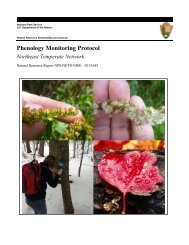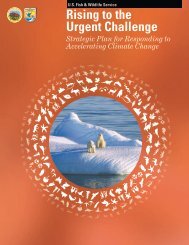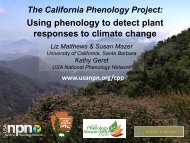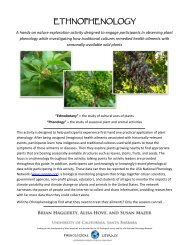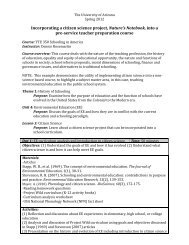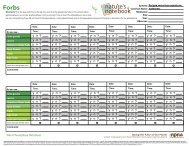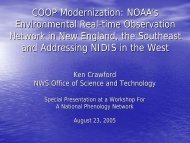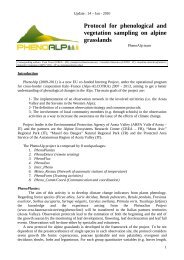The Phenology Handbook - USA National Phenology Network
The Phenology Handbook - USA National Phenology Network
The Phenology Handbook - USA National Phenology Network
Create successful ePaper yourself
Turn your PDF publications into a flip-book with our unique Google optimized e-Paper software.
<strong>The</strong> fingerprint of climate change<br />
<strong>The</strong>se shifts in geographic range and phenology are what scientists call the “fingerprint of climate change.” What<br />
at first appears to be a situation where a species is accommodating or “adapting” to climate change by altering<br />
the pace and duration of its annual cycle may actually be a risk-filled response — phenological schedules are<br />
changing rapidly and at different rates for co-dependent species such as plants and pollinators. <strong>The</strong>re is an increasing<br />
number of reports in recent years of population crashes in the wild due to asynchronous responses to<br />
climate change among co-dependent species, but we are only beginning to learn how widespread they are and<br />
in how many different kinds of organisms they occur.<br />
One consequence of asynchronous phenological responses to climate change among interacting species<br />
<strong>The</strong> Dutch Pied Flycatcher (Ficedula hypoleuca) is a small passerine bird that migrates from Western Africa<br />
to Europe each spring. Upon its arrival at its northern breeding grounds it consumes caterpillars. <strong>The</strong> caterpillars<br />
have been responding to warmer spring temperatures by emerging as adults earlier in the spring,<br />
but some Flycatcher populations have not migrated earlier to keep pace. <strong>The</strong>se mistimed Flycatcher populations<br />
have been in steep decline in recent years because of the asynchrony of their migration phenology<br />
with the phenology of their food source at its breeding grounds.<br />
Photo freely available from Aelwyn and the Wikimedia Project.<br />
CC-BY-SA terms of usage available at www.wikimedia.org<br />
Visser, ME, C. Both, and MM Lambrechts. 2004. Global climate change leads to mistimed avian reproduction. Advances in Ecological<br />
Research 35: 89-110.<br />
Durant, J. M., D. O Hjermann, G. Ottersen, and NC Stenseth. 2007. Climate and the match or mismatch between predator requirements<br />
and resource availability. Climate Research 33: 271-283.<br />
20



